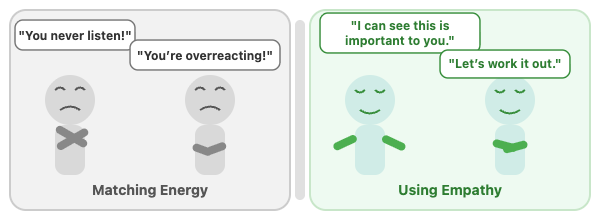Even when you do your best to be fair and open, people might still react with crossed arms, raised voices, or say things like, “That’s not what happened!” This is called defensiveness. It’s a normal response when someone feels threatened, judged, or misunderstood. It doesn’t mean you did something wrong—conflict just makes people feel vulnerable.
When you notice defensiveness, stay calm and don’t get pulled into the same energy. If you match their frustration or get defensive yourself, things usually get worse. Instead, be the steady person in the room. Take a breath, slow down, and remember that their reaction is about how they feel—not about you.
The best way to lower defensiveness is to show empathy. This means letting the other person know you see their feelings, even if you don’t agree with them. You can say things like, “I can see this is really important to you,” or “It sounds like this has been frustrating.” You’re not saying they’re right or wrong—just that you care about how they feel.
Using neutral language also helps. Instead of saying, “You’re overreacting,” try, “I can see this situation is having a big impact on you.” Use “I” statements to share your own perspective, like, “I’m feeling confused about what happened,” instead of, “You’re not making sense.” This keeps the conversation open and less likely to turn into an argument.

Defensiveness isn’t always obvious. Sometimes it’s loud and clear, but other times it’s more subtle. Learning to spot the signs early—both in others and in yourself—can help you change your approach before things get out of hand.
Physical signs might show up as someone crossing their arms, turning away, tightening their jaw, clenching their fists, or suddenly changing their eye contact. They might avoid your gaze or stare intensely. You might also notice their voice getting louder, or the opposite: they go quiet and withdrawn.
Verbal signs often include words like “always” or “never,” as in, “You never listen to me!” People might bring up old issues, say things like “Well, what about last time?”, make counter-accusations such as “You do the same thing!”, or start over-explaining and justifying every little action.
Emotional signs in yourself can be more subtle. You might feel hot or tense, have the urge to interrupt, or catch yourself thinking, “That’s not fair!” or “They don’t get it.” Sometimes, you’ll notice you’re planning your comeback instead of really listening.
Common triggers for defensiveness include feeling misunderstood, being criticized in front of others, having your abilities questioned, or feeling like your values are under attack. If you notice these signs, pause and check in with yourself or the other person. Sometimes just saying, “I notice this is getting tense. Let’s slow down,” can help everyone reset.
Once you’ve spotted defensiveness and responded calmly, the next step is to guide the conversation back to problem-solving. To help with this, you can use The Redirect Method.
- Pause when things get heated. If emotions are running high, it’s okay to take a short break. This gives everyone a chance to calm down and think more clearly.
- Reframe the conversation. Instead of focusing on who’s right or wrong, shift to, “How can we solve this together?” This turns the conversation from a fight into a team effort.
- Focus on the future. Don’t get stuck arguing about the past. Ask questions like, “What can we do differently next time?” or “How can we make sure this doesn’t happen again?” This helps everyone move forward instead of staying stuck.
- Invite their ideas. People are less defensive when they feel included. This shows respect and helps turn frustration into creative problem-solving.
If things still feel stuck, talk about the conversation itself. You can say, “It feels like we’re going in circles. What would help us move forward?” Sometimes naming the problem out loud is enough to break the cycle.
Here’s how it might sound:
- Jessica: You never listen to my suggestions!
- Ryan: Let's pause for a second.
- Ryan: I hear that you’re frustrated about not being heard. Going forward, what would help you feel more included in decisions?
- Jessica: Maybe we could have a quick check-in before any big choices are made.
- Ryan: That sounds like a good plan. Let’s try it and see how it works for both of us.
Notice how Ryan pauses to reset the conversation, stays calm, and acknowledges Jessica’s feelings. Then invites her ideas for a solution. This is the Redirect Method in action—moving from tension to teamwork.
By staying calm, showing empathy, and gently steering the conversation toward solutions, you can turn defensive moments into real progress. With practice, these skills will help you handle tough conversations with more confidence and less stress. Up next, you’ll get a chance to try out these techniques in realistic practice scenarios, so you can build your confidence before using them in real life.
